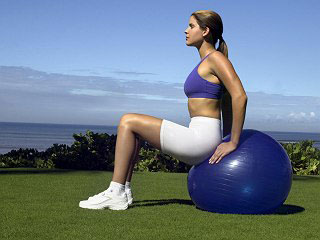Shape up with a swiss ball
By Andrew McCallum (New Zealand Fitness Magazine)
Updated: 2007-02-01 16:28
 |
Large Medium Small |
Balance balls, fit balls, stability balls or Swiss balls (SB) as we call them are harmless, yet humbling looking large, inflated, rubber or vinyl balls which first appeared in the early 1960s, mostly in the realm of physical therapy. It is only throughout the course of the past decade that they have slowly crept into mainstream fitness.
Like many new ideas and theories relating to fitness, an underlying resistance to SB training has been prevalent. But rest assured, with all the facts at hand, you too could effectively develop balance and strength with SB training.
Four Key Factors
In examining what makes SB training so effective we need to consider four key factors:
Owing to its obvious instability, the SB challenges the nervous system and improves your ability to maintain balance, which is particularly important, as we age. With such a high level of nervous system activation there is a high level of carry-over into day-to-day activities.
Improved stabiliser muscle functions helps keep joints stable. Most joint injuries can be traced to joint instability.
The SB promotes full range of movement training that is vital for maintaining a balanced musculoskeletal system.
The unstable SB provides an ideal medium to engage the often-neglected muscles of the core and torso. This increases the overall effect and efficiency of each exercise, resulting in a more effective workout.
Decreased Base Of Support = Increased Muscle Activity
Just as the most stable building design will always have the strongest foundation, the human body requires a sturdy base of support for maximal stability or balance.
Try this activity: stand up straight, relax and slowly bend one knee lifting that foot off the ground and hold that position. As soon as one foot leaves the ground your body begins a torrid battle to maintain balance. Now if you can hold this position for any length of time you will immediately start to feel tightness in the muscles of the supporting leg.
The reasons for this are twofold. Firstly, the leg is in the unaccustomed position of supporting all of your bodyweight. Secondly, and more significantly, the muscles, nerves and connective tissue in your leg, pelvic area and core have to work intensely to maintain your body's upright stance.
The SB is the ideal medium for a reduced base of support. Because it is inherently unstable, the body immediately springs into action when sitting on it in order to maintain its position. Furthermore, depending on the activity being performed, simply lifting a foot off the ground when seated will again significantly reduce your base of support.
Increased Core Strength = Increased Strength Potential
The body's core is essentially the foundation of all bodily movement. The core encompasses both the back and front of the torso, the muscles of the abdominals and lower back. It is where the stabilisation, innervation and production of movement originates.
A strong core can improve posture, balance and muscular coordination, increase body momentum and decrease the risk of injury.
Most of the time, your expression of strength is limited by what you can stabilise. To test this theory, try this exercise with a training partner. Stand face to face and have him (or her) extend their arm out straight resting their forearm on your shoulder with their palm facing up.
| 分享按钮 |
